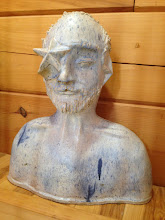
In the photo below, the door is being closed by stacking bricks.

The fuel for the kiln is hardwood scrap obtained from a local lumber mill. It takes approximately 20 to 22 hours reach the desired temperature. Stoking takes place about every 5 to 10 minutes within that period.

The wood burns held on grates above the ash pit. The amount of air entering the kiln is controlled via holes in the side of the firebox. These can be seen between the two stacks of wood

Dampers in the chimney control how fast the hot gases pass through the kiln. There are two types on this kiln, active and passive. The lower active dampers are plates which physically block off the chimney. The passive dampers are removable bricks directly above the active dampers. When these bricks are removed, the hole in the chimney slows the flow of hot gases down but in a more subtle way.

The progress of the firing is monitored by the watching "cones". These cones are designed to bend when a certain amount of heat has been added to the ware. Typically, the firing is done when cone 10 bends down at approximately 2350 degrees.

The flames reach all the way through the kiln and up the chimney. A awesome site.


No comments:
Post a Comment